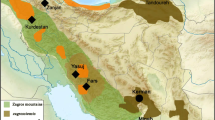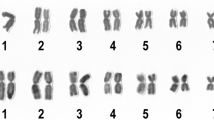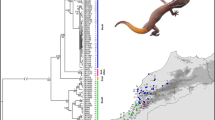Abstract
Seven species of dwarf lemurs (Cheirogaleus spp.) are currently recognized after a recent revision of the genus. During a field study in southeastern Madagascar, we observed 3 distinct morphotypes of Cheirogaleus resembling Cheirogaleus medius, C. major and C. crossleyi. In particular, for Cheirogaleus crossleyi southeastern Madagascar was far away from the known distribution range of the species when referring to the recent revision of the genus. In order to clarify the taxonomic status of the 3 morphotypes, we compared field samples from southeastern Madagascar to museum specimens from several locations in Madagascar and to field samples from Kirindy/CFPF, western Madagascar by genetic analyses using the mitochondrial cytochrome b gene. Genetic data yield strong support for 2 of the 3 morphotypes to represent Cheirogaleus medius and C. major. The third morphotype is genetically closely related to Cheirogaleus crossleyi, albeit more distantly than the other 2 morphotypes to the respective reference samples. The genetic distance is related to a considerable geographic distance between the location of our field study and the origin of the respective reference specimen, because Cheirogaleus crossleyi had been reported only from northern Madagascar. Our field observations indicate an isolated population in southeastern Madagascar. We propose to identify them as Cheirogaleus crossleyi and discuss the population genetic and biogeographic considerations supporting this conclusion.
Similar content being viewed by others
References
Arctander, P. (1995). Comparison of a mitochondrial gene and a corresponding nuclear pseudogene. Proc. R. Soc. Lond. B Biol. Sci. 262(1363): 13–19.
Avise, J. C., Neigel, J. E., and Arnold, J. (1984). Demographic influences on mitochondrial DNA lineage survivorship in animal populations. J. Mol. Evol. 20: 99–105.
Bird Life International (2003). Bird Life’s online World Bird Database: the site for bird conservation. Version 2.0. Cambridge, UK: BirdLife International. Available: http://www. birdlife.org (accessed 4/5/2004).
Castresana, J. (2001). Cytochrome b phylogeny and the taxonomy of great apes and mammals. Mol. Bio. Evol. 18(4): 465–471.
Donque, G. (1972). The climatology of Madagascar. In Battistini, R., and Richard-Vindard, G. (eds.), Biogeography and Ecology in Madagascar. W. Junk, The Hague, pp. 87–144.
Donque, G. (1975). Contribution gépllographique à l’étude du climat de Madagascar. Nouvelle Imprimérie des Arts Graphiques, Antananarivo, Madagascar.
Felsenstein, J. (1993). PHYLIP (Phylogeny Inference Package) version 3.5c, Distributed by the author. Department of Genetics, University of Washington, Seattle.
Feistner, A. T. C., and Schmid, J. (1999). Lemurs of the Réserve Naturelle Intégrale d’Andohahela, Madagascar. In Goodman, S. M. (ed.), A Floral and Faunal Inventory of the Réserve Naturelle Intégrale d’Andohahela, Madagascar: With Reference to Elevational Variation, Fieldiana Zoology New Series 94, pp. 269–283.
F. T. M. (1961a). Carte de Madagascar au 1:100,000, Feuille O-61, Sainte Luce, Foiben-Taosarintanin’i Madagasikara, Antananarivo.
F. T. M. (1961b). Carte de Madagascar au 1:100,000, Feuille N-61, Ranomafana du sud, Foiben-Taosarintanin’i Mgasikara, Antananarivo.
F. T. M. (1979). Carte topographique au 1:100,000, Feuille M-62, Ranopiso, Foiben-Taosarintanin’i Madagasikara, Antananarivo.
F. T. M. (1990). Carte de Madagascar au 1:100,000, Feuille N.O.-62, Tôlanaro, Foiben-Taosarintanin’i Madagasikara, Antananarivo.
F. T. M. (1991). Carte régionale 1:500,000 No 11, Ampanihy, Foiben-Taosarintanin’i Madagasikara, Antananarivo.
Goodman, S. M., Pidgeon, M., Hawkins, A. F. A., and Schulenberg, T. S. (1997). The Birds of Southeastern Madagascar, Fieldiana Zoology New Series 87.
Grandidier, A. (1892). Carte du pays d’ Anosy par Modave (1768). Histoire physique naturelle et Politique de Madagascar. Vol. 1 Histoire de la géographie. Atlas, 2. Partie, Paris, Hachette, plate 38.
Greenwood, P. J. (1980). Mating systems, philopatry and dispersal in birds and mammals. Anim. Behav. 28: 1140–1162.
Geoffroy Saint-Hilaire, E. (1812). Notes sur trois dessins de Commerçon. Ann. Mus. d’Hist. Nat., Paris, 19: 171–175.
Groves, C. P. (2000). The genus Cheirogaleus: unrecognized biodiversity in dwarf lemurs. Int. J. Primatol. 21(6): 943–962.
Hall, T. A. (1999). BioEdit: a user-friendly biological sequence alignment editor and analysis program for Windows 95/98/NT. Nucl. Acids. Symp. Ser. 41: 95–98.
Hasegawa, M., Kishino, H., and Yano, T.-A. (1985). Dating of the human-ape splitting by a molecular clock of mitochondrial DNA. J. Mol. Evol. 22: 160–174.
Hawkins, A. F. A., Chapman, P., Ganzhorn, J. U., Bloxam, Q. M. C., Barlow, S. C., and Tonge, S. J. (1990). Vertebrate conservation in Ankarana Special Reserve, northern Madagascar. Biological Conservation 54: 83–110.
Hofreiter, M., Serre, D., Poinar, H. N., Kuch, M., and Pääbo, S. (2001). Ancient DNA. Nature Reviews, Genetics 2: 353–359.
Huelsenbeck, J. P., and Ronquist, F. (2001). MrBayes: Bayesian inference of phylogeny. Bioinformatics 17: 754–755.
Huelsenbeck, J. P., Larget, B., Miller, R. E., and Ronquist, F. (2002). Potential applications and pitfalls of Bayesian Inference of phylogeny. Systematic Biology 51: 673–688.
Jenkins, P. D., (1987). Catalogue of Primates in the British Museum (Natural History) and elsewhere in the British Isles. Part IV: Suborder Strepsirrhini, including the Subfossil Madagascan Lemurs and Family Tarsiidae, British Museum (Natural History), London.
Kimura, M. (1980). A simple method for estimating evolutionary rate of base substitutions through comparative studies of nucleotide sequences. J. Mol. Evol. 16: 111–120.
Kumar, S., Tamura, K., Jakobsen, I. B., and Nei, M. (2001). MEGA2: Molecular Evolutionary Genetics Analysis software, Arizona State University, Tempe, Arizona, USA
Li, W.-H. (1993). Unbiased estimation of the rates of synonymous and nonsynonymous substitution. J. Mol. Evol. 36: 96–99.
Lowry, P. P., and Faber-Langendoen, D. (1991). Madagascar Minerals Project, Contract no. MMC-0093 and MMC-0109. Environmental Impact Assessment Study. Part I: Natural Environment. Appendix III: Flora and Vegetation Study.
Martin, R. D. (1972). Adaptive radiation and behavior of the Malagasy lemurs. Philosophical Transactions of the Royal Society of London, B 264: 295–352.
Pamilo, P., and Bianchi, N. O. (1993). Evolution of the Zfx and Zfy genes: Rates and interdependence between the genes. Mol. Biol. Evol. 10: 271–281.
Paulian, R., Blanc, C., Guillaumet, J.-L., Betsch, J.-M., Griveaud, P., and Peyriéras, A. (1973). Étude des écosystémes montagnards dans la région malgache. II. Les chaînes Anosyennes. Géomorphologie, climatologie et groupements végétaux. (Campagne RCP 225, 1971–1972). Bulletin Muséum National d’Histoire Naturelle, Écologie génerale, third series, 118: 1–40.
Petter, J.-J., Albignac, R., and Rumpler, Y. (1977). Mammiféres lémuriens (Primates prosimiens). Faune de Madagascar, No. 44, ORSTOM-CNRS, Paris.
Petter, J.-J., and Petter-Rousseaux, A., (1979). Classification of the Prosimians. In Doyle, G. A. and Martin, R. D. (eds.), The study of Prosimian Behavior, Academic Press, London, pp. 1–44.
Petter, J.-J., and van der Sloot, J.-H. (2000). Lemurs of Madagascar and the Comoros, World Biodiversity Database CD-ROM Series, ETI Expert Center for Taxonomic Identification, Amsterdam.
Rasoloarison, R. M., Goodman, S. M., and Ganzhorn, J. U. (2000). Taxonomic revision of mouse lemurs (Microcebus) in the western portions of Madagascar. Int. J. Primatol. 21(6): 963–1019.
Ratsivalaka-Randriamanga, S. (1985). Recherches sur le climat de Tolagnaro (ex Fort Dauphin) (Extrême Sud de Madagascar). Madagascar, Revue de Géographie, 46: 47–67.
Schmid, J., and Kappeler, P. M. (1994). Sympatric Mouse Lemurs (Microcebus) spp. in Western Madagascar. Folia Primatol. 63: 162–170.
Strimmer, K., and von Haeseler A. (1996). Quartet puzzling: a quartet maximum-likelihood method for reconstructing tree topologies. Mol. Biol. Evol. 13: 964–969.
Tattersall, I., (1982). The Primates of Madagascar, Columbia University Press, New York.
Swofford, D. L. (1998). PAUP*. Phylogenetic analysis using parsimony (*and other methods). Version 4. Sinauer Associates, Sunderland, MA.
Yoder, A. D., Burns, M.-M., and Genin, F. (2002). Molecular evidence of reproductive isolation in sympatric sibling species of mouse lemurs. Int. J. Primatol. 23(6): 1335–1345.
Yoder, A. D., Rasoloarison, R. M., Goodman, S. M., Irwin, J. A., Atsalis, S., Ravosa, M. J., and Ganzhorn, J. U. (2000). Remarkable species diversity in Malagasy mouse lemurs (Primates, Microcebus). PNAS 97 (21): 11325–11330.
Zischler, H., Geisert, H., von Haeseler, A., and Pääbo S. (1995). A nuclear fossil of the mitochondrial D-loop and the origin of modern humans. Nature 378: 489–492.
Author information
Authors and Affiliations
Corresponding author
Rights and permissions
About this article
Cite this article
Hapke, A., Fietz, J., Nash, S.D. et al. Biogeography of Dwarf Lemurs: Genetic Evidence for Unexpected Patterns in Southeastern Madagascar. Int J Primatol 26, 873–901 (2005). https://doi.org/10.1007/s10764-005-5327-0
Received:
Accepted:
Issue Date:
DOI: https://doi.org/10.1007/s10764-005-5327-0




